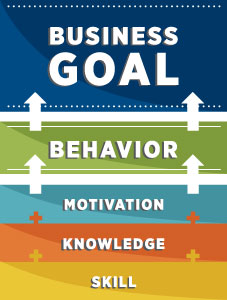How to Reframe the Problem and Raise the Bar of Performance Management
 THE FLOP WAS A HUGE SUCCESS
THE FLOP WAS A HUGE SUCCESS
In the 1968 Olympics in Mexico City, gold-medal high jumper Dick Fosbury reframed the problem of jumping over a bar by “flopping” backwards over it. Over 40 years later, the “Fosbury Flop” is still the dominant technique used in high jumping.
While process improvement techniques such as Six Sigma or problem solving techniques such as Root Cause Analysis are effective when digging deeper for solutions, users of these techniques may miss insightful solutions that require them to dig elsewhere, to dig backwards, or even to build rather than dig.
Reframing the problem (challenge, need, goal, etc.) often uncovers unarticulated needs and outdated assumptions. If Fosbury used these “dig deeper” techniques to improve his performance of the traditional straddle jump he would not have uncovered the faulty assumption that jumping forward is the best technique. He also would not have uncovered the unarticulated need of foam rubber mats instead of sand pits to allow a safe backward landing.

Connect All 9 Dots w/ no more than 4 straight lines without lifting your pencil
REFRAMING IS SEEING THE “HIDDEN” SPACE
This classic nine dot puzzle is a simple yet good example of needing to reframe the problem to find the solution. Just like solving this puzzle, if we focus more closely or “deeply” on the dots we will never reframe the problem or find the solution, however if we reframe the problem by broadening or shifting our perspective to the “hidden” space surrounding the dots, a solution is possible.
So how does REFRAMING relate to Learning & Development (L&D) and performance management? How can we reframe the common problems we are trying to solve in L&D to achieve uncommon insights and epiphanies? First, rather than jumping immediately into designing a solution, we should broaden our perspective and assess the problem.
MAPPING THE PROBLEM
During the upfront needs analysis phase of L&D projects, many L&D problems need to be reframed from “learning and understanding” OUTPUT problems to “human performance” OUTCOME problems. This is often called “performance mapping,” which is working backward from the performance goal or desired result to required behaviors to required skills, knowledge, and motivation.
Let me illustrate with an example. A fast food restaurant chain wanted an L&D solution to help their employees increase the speed and efficiency of its drive-thru service. The client had data showing that competitors were faster. Typical L&D approaches would begin by focusing on how to train relevant knowledge, skills , and motivation (understanding the drive-thru process steps, provide practice opportunities, explore and discuss reasons why this is important.) Better L&D approaches would begin by focusing on and analyzing the critical behaviors required. In this example, neither would have achieved significant results.
The ONLY L&D approach that was significantly successful, was stepping back, broadening and reframing the problem to “improving the speed and efficiency of drive thru service” and then convincing the client to methodically observe and experience the drive-thru service (this is called ethnographic research). What the L&D team uncovered in their assessment was that the slower speed of the drive thru service what not due to employee performance but due to customer performance. The customer was taking more time to decide what to order because of the drive thru menu. It offered more choices and was more complicated than competitor drive thru menus. Problem reframed.
BEYOND ANALYZING – OBSERVING AND EXPERIENCING THE REAL PROBLEM
Even when “digging” and analyzing human performance problems using methods such as secondary research, surveys, or interviews, these less involved approaches rarely allow us to see outside of the established frame of reference. Instead we must get more involved and more perspective by conducting observational and experiential analyses – actually observe behaviors and have experiences – even step into their shoes. Again, this seems deceptively simple (although time-consuming). However, the rigor is in the humble, unbiased, curious, and methodical approach that allows the reframing of the problem and the seeing of the outdated assumptions, the unarticulated needs, and removable barriers.
By the way, reframing solutions can have significant benefits as well. (Think of 3M Post-it notes – a glue that didn’t stick, Glide dental floss – a woven fiber that happens to stick to plague, colored duct tape – a multi-purpose tape turned into a multi-purpose decoration, etc.)
Reframing the problem (or solution) to find a better one is invaluable. The challenge is investing the time and resources to insightfully uncover it.





